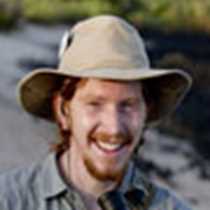Today we awoke surrounded by the Bainbridge Islets and Chinese Hat. It was an early outing with great weather conditions. It was a unique opportunity to explore the coast of Chinese Hat and Santiago by Zodiac or by kayak. The waters were calm and the sun was coming through the clouds, shining over the incredible landscape of dark twisted basalt lava. In this area we got to see three Galapagos penguins preparing for fishing and soon one jumped into the water and was out of sight. There were striated herons as well as brown noddies, swallow tailed gulls, several pelicans looking for fish and frigates flying effortlessly around Chinese Hat.
After this we came back for breakfast and then got ready for deep water snorkeling. We went exactly to the same place where the Zodiac ride and kayaking took place and we were eager to get into the water. This is certainly the best snorkeling site of the week and today we marveled at the magnificent underwater life! There was plenty of plankton at the surface that attracted a big school of Creole fish, razor surgeonfish, white tipped reef sharks (adults as well as baby sharks), sea stars, salemas, puffer fish, a huge marble ray and many other fish! It was so helpful that the water was so clear that several expressions were heard such as amazing, incredible, the best snorkeling so far!
Several of our guests decided to spend their morning visiting a small white sandy beach on Chinese Hat where they enjoyed the company of a playful Galapagos penguin that decided to give them a private show of fishing in shallow waters!
After lunch the National Geographic Islander navigated close to a nearby islet with a brackish water lagoon where a dozen of flamingoes were spotted. Our Captain, Patricio Jaramillo, continued the navigation toward the next destination Sullivan Bay, located on Santiago Island.
In the afternoon, before disembarkation, a great lecture about Darwin was held by our Expedition Leader, Lynn Fowler. On board, learning is a constant activity that we love to share with our guests. Soon afterward there was time to get ready for a dry landing. Good shoes were required as well as a walking stick. It is hard to explain this site, it exemplifies the beginning of life and at the same time shows the power of nature’s destruction. The lava flow that covered this area emerged in 1897 and it looks like it was just yesterday. We are able to witness the process of colonization of plants and animals of a newly formed place. This lava has incredible shapes and it is so amazing to be walking on a place like this. In this barren environment we were able to find painted locusts, lava lizards and several pioneer plants such as lava cactus and Mollugo. We were all very grateful for the nice cover of clouds that offered ideal conditions for this outing.
After dinner we all enjoyed a casual night with live music thanks to Christian Saa, who is not only a member of the Natural History team, but also a talented musician! Another great day came to an end in the magical islands of Galapagos!









